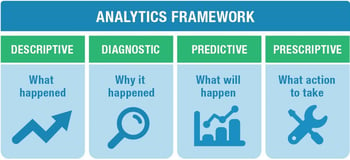 Each analyst at LNS Research not only has topical coverage, mine being Asset Performance Management (APM) and Enterprise Resource Planning (ERP), but industry focus based on our previous experience. In my case, one of the industries I focus on is mining & metals. I find it helpful to stay in touch with other thought leaders and research activities throughout the industry. During any dialogue or legwork, it's not unusual for the Predictive Analytics gold rush to find its way into the conversation.
Each analyst at LNS Research not only has topical coverage, mine being Asset Performance Management (APM) and Enterprise Resource Planning (ERP), but industry focus based on our previous experience. In my case, one of the industries I focus on is mining & metals. I find it helpful to stay in touch with other thought leaders and research activities throughout the industry. During any dialogue or legwork, it's not unusual for the Predictive Analytics gold rush to find its way into the conversation.
Click here to speak to Dan
One group that fosters mining industry research globally is AMIRA International with head offices in Melbourne Australia. In discussing one of AMIRA’s recent white papers, Achieving Interoperability across the Minerals Value Chain – Phase 1 Surface Mining Equipment, with its author we drifted into a dialog about the future of Predictive Analytics in mining. He noted that being in the mining field, Predictive Analytics was like a gold rush right now. Some might strike it rich, most would go bust and it would only be saloon operators and the provisions providers that made any real money off the boom. That got me to thinking about the state of Predictive Analytics and just who is going to make money in the Rush of 2016?
Predictive Analytics – There’s Gold in Them Thar Hills!
This 1800’s and early 1900’s expression exhorting people to go find the gold in the local terrain actually is quite appropriate for Predictive Analytics today. In business, any technology investment ultimately must tie back to financial benefits. One technology that consistently has proven it can deliver economic benefits is Predictive Analytics; particularly when used to improve either production asset reliability or product quality. Sometime the savings can be significant. It is not uncommon to hear of cases where Predictive Analytics has alerted operators to impending failures that are then avoided resulting in cost avoidance savings in the six or even seven-digit range. Multimillion dollar savings are possible if a catastrophic failure on an offshore oil platform is prevented or a continuous caster in a steel mill can avoid an unplanned shutdown.
We have also heard quality stories where Predictive Analytics has helped companies avoid hundreds of thousands of dollars in recall costs; claims payments or customer service issues by preventing the shipment of goods that did not meet specifications. With these types of hard dollar savings attributed to Predictive Analytics, it is no wonder that almost every couple of weeks LNS hears about another startup company delivering capabilities in this area. It does actually seem like the gold rush days of the 1800’s. Everyone is trying to stake a claim.
Panning for Gold Reflects the Current Market Conditions
If one looks back to the 49ers of the California gold rush that might be the best model to describe the state of the market today. The almost overwhelming number of new entrants into the Predictive Analytics space are a bit like the mix of individual prospectors. They are out panning every little stream, while the larger companies are both pursuing major finds as well as buying up the claims when the prospectors strike what seems to be a profitable vein.
The problem is that it seems the prospectors today, just as back in the California gold rush, are mostly just eking out a survival by focusing on narrow niches associated with specific industries or an esoteric aspect of predictive analytics. They are competing against the bigger players like SAS, IBM or the ERP/EAM players, who are like the hydraulic miners of the past. They are just blasting away at the market hoping to wash something out, opting for volume but with the potential for washing out more than just the high value minerals.
These Big Data approaches are like sluice boxes, sifting through tons of gravel to find the gold where the prospectors panning techniques were more focused. It remains to be seen as to whether any focused, but large companies emerge from the current environment. Will we see the emergence of a large Predictive Analytics company, or will it be diversified enterprise application providers that include Predictive Analytics in their portfolio that ultimately win?
The Provisions Providers are the Immediate Winners
Just as in the California gold rush, the ones that are making the most are not the miners. The provisions providers that are selling the tools and infrastructure are making the early money. In Predictive Analytics this means the platform providers like Microsoft with Azure Analytics, which serves as the engine behind many of the smaller focused analytics solutions, is one winner as is Amazon with its Machine Learning tools built on their web services platform, AWS.
